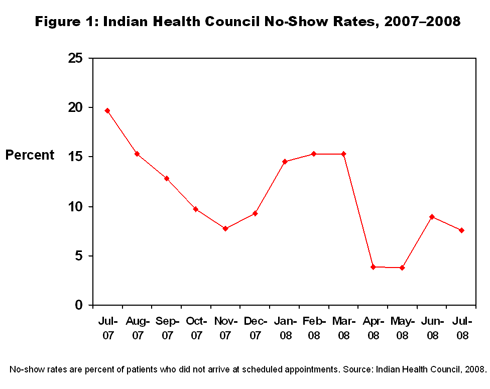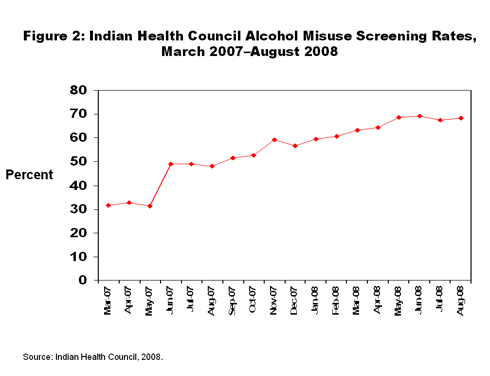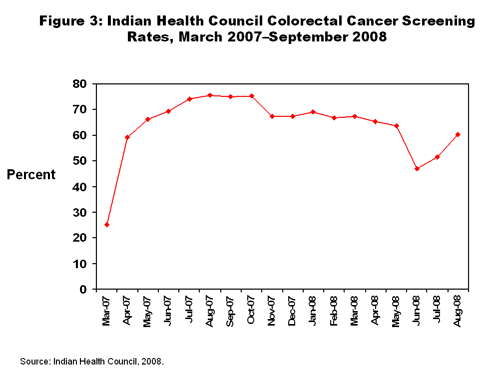By Sarah Klein
Issue: Improving the care of patients with chronic health conditions has been a long-term goal for the Indian Health Council, a consortium of nine tribes that provides medical services to Native Americans living on nine reservations in North San Diego County. As a group, American Indians/Alaska Natives suffer disproportionately high rates of diabetes, cardiovascular disease, and asthma, among other chronic conditions.[1] Better chronic care not only could improve those patients' quality of life, but also might prevent emergency room visits to area hospitals, which sap financial resources from the tribally run clinic's $14 million annual budget.[2]Clinic leaders also hoped the strategy of assigning patients to dedicated teams of providers would overcome some longstanding challenges, including patients' frustration with being treated by different staff members, some of whom were assigned to the clinic on a short-term basis to fulfill their obligations for medical education loans or National Guard duty. "Every time patients would come to the clinic, they'd have to retell their story [to a different physician]," says Corinna Nyquist, R.N., the clinic's director of ambulatory services. A "medical home"—one that provided patients with accessible, continuous, and coordinated care—might engage patients more, the clinic leaders reasoned.
In teams, the providers also might devise new methods for overcoming the fatalism expressed by patients from older generations, who tended to view chronic conditions such as diabetes and cardiovascular disease as neither preventable nor manageable. The clinic wanted to attract those patients to the clinic, as well as younger patients who had inherited the elders' skepticism about the quality of care provided there.
The clinic leadership believed the team approach would give providers a more complete view of the challenges that patients on the reservations faced in trying to manage their illnesses. Some patients lacked telephones, while others had trouble getting to the clinic during inclement weather. Many others were worried about privacy, since they often knew many of the clinic staff who had worked there a long time and/or lived on the reservations.
Organization and Leadership: The Indian Health Council has five primary care physicians, four nurses, and nine medical assistants on its full-time staff; these clinicians rotate through two ambulatory care clinics. The first clinic, a 50,000-square-foot facility in Valley Center, Calif., serves as the main office; a smaller satellite clinic is located in the mountainous area of San Ysabel, Calif. Both are in relatively rural areas, east of Escondido, Calif (see Map).

The Council also contracts with several clinicians to provide specialty services, including cardiology, ophthalmology, obstetrics and gynecology, podiatry, chiropractic care, and acupuncture, on a weekly or biweekly basis.
It receives support from four community health representatives, health paraprofessionals who provide outreach and education to the residents of the reservations, as well two to three public health nurses, who perform home visits and deliver information on disease prevention programs. (Health promotion and disease prevention is another priority initiative within the Indian Health Service.) "I call them my search-and-seize team," Nyquist says, because they are often successful at finding patients the clinic has been trying to reach.
In all, the two clinics have 21,000 patients registered within the Indian Health Council system. Of those patients, 6,400 have visited the clinics at least once in the last three years and 4,900 have visited the clinics at least two times in the last three years.
Nyquist, who has been with the Indian Health Council since 2000, oversees the chronic care pilot program. Others who are actively involved include Daniel Calac, M.D., the council's chief medical officer, a nurse practitioner, and two medical assistants.
Target Population: Providers at the two clinics see patients of all ages. Roughly 40 percent of their patients have one or more chronic conditions such as diabetes, obesity, cardiovascular disease, or asthma.
Process of Change: The Indian Health Council was selected as one of 14 pilot sites for the Indian Health Service's Innovations in Planned Care initiative in March 2006.[3] Soon after, it began meeting with organizers of the project from the Indian Health Service and the Boston-based Institute for Healthcare Improvement, which collaborated on the initiative. [4]
In conjunction with those two organizing groups, the clinic established goals for the project, including assigning nearly 5,000 patients to one of several provider teams within four to six months. The clinic focused on all patients, since so many had or were at risk of developing chronic conditions. The teams would be comprised of two physicians, one nurse, and two or three medical assistants. Each team would be measured on its success in administering evidence-based screening tests and conducting patient exams.
To start, the Indian Health Council built a single team focused around one nurse practitioner, Mary Jo Moses, F.N.P., who Nyquist says was "willing, motivated, and eager for change. That's what they recommended: find someone who really could help motivate other people." Using the Indian Health Service' Resource and Patient Management System (an internally developed information system), the clinic looked for patients who had seen Moses two or three times within the last 18 months. The 772 identified patients were assigned to her team. Moses served as the provider for the team.
Moses' team spent 30 minutes at the start of each day reviewing the charts of patients scheduled for clinic visits. The goal of this meeting—or "huddle," as it was called—was to identify and plan for medical tests or exams that were needed, including immunizations, mammograms, and physicals. For tests that could be completed before the exam, such as in-house labs, the physician wrote orders at the morning meeting.
This initial chart review proved to be an overwhelming process for team members, even though they were aided by a Windows-based software interface (iCare, see In Focus for detail) that identified and flagged missing lab work, tests, and patient education, Nyquist says. The records themselves were part of the problem. Because of data entry errors, some charts had the names of primary care providers and lab technicians reversed. In other cases, the clinic had not recorded results for off-site tests. To fix the records and keep them accurately updated, program leaders decided to train all of the clinics' nurses and medical assistants on data entry, instead of relying on a single person, as it had been doing.
"Initially, it seemed like a lot of extra work," Nyquist says. Yet, within four or five months, after the data entry problems were corrected and the team had a chance to catch up on missing tests and patient education, "things went a lot smoother." Providers had more time to ask patients open-ended questions—"What is it you want from me today?" or "What are your goals?"—that deepened their understanding of the patients and their needs.
A few patients were taken aback by this new approach, Nyquist says. "Some of them were shocked when we asked, 'What can we do for you today?' [Some said,] 'Well, I don't know. You always tell me why I'm here.' It's a role reversal. It was hard on both sides."
As the pilot progressed, patients began to feel more comfortable. "The patients are generally a little bit more open with what they are able to do and what they can't do when we ask them," Nyquist says. One patient who had an abnormal breast exam insisted it wasn't a priority to get a diagnostic mammogram, as she had a family to feed and work to do. As a team, the providers called her repeatedly to stress the importance of the test, which she ultimately agreed to get. "She ended up having cancer. But we moved through the rest of the [treatment] process relatively quickly," says Nyquist. As a result of the approach, the patient had treatment immediately and is doing well.
In another case, an elderly patient's daughter called to say her mother wasn't acting quite right. Because the team knew the patient and her medical history, they agreed that the symptoms suggested the patient needed care and directed the daughter to take her mother to the hospital. The team "knows the patient. It's not…second guessing everything," Nyquist says.
The clinic expanded the empaneling process to other teams after 12 months, slightly later than it had intended because two physicians objected to the team model and left the clinic. In all, 74 percent of patients have been assigned to a team. Clinic leaders plan to report outcomes for all of the teams later this month. "We are hoping to elicit competition [among them]," Ms. Nyquist says. They also will have an opportunity to learn from one another. "As we are just beginning this process, we will use our monthly staff development meeting to review outcomes and ask each team to complete a Plan-Do-Study-Act worksheet . . . in which they will report outcomes, good or bad, to the [entire group]," Nyquist says.
Key Measures: To gauge the impact of the pilot program, the Indian Health Council used national quality measures for primary care. The measures included broad health indicators, such as cholesterol levels, blood pressure control, and immunization rates, as well as specific tests related to chronic conditions, including cancer, depression, diabetes and asthma, among others.
The clinic also measured patient satisfaction levels quarterly and staff satisfaction levels biannually.
To gain a sense of whether being assigned a primary care provider resulted in greater numbers of patients showing up for appointments, the clinic also measured no-show rates.
Results: The clinic found that its no-show rates, the measure of patients who simply skipped appointments, dropped to slightly less than 4 percent in April 2008 from nearly 20 percent in July 2007 within the trial group (Figure 1). Nyquist attributes this change to patients' reluctance to skip visits with providers with whom they have developed relationships.



"What we found out is that, a lot of times, the patients didn't realize they had to have certain tests annually or more than annually," Nyquist says. Patients who received notices for exams would say, "'Oh, I already had it,' and ignore it," she says. "Now we have a scorecard we give to the patients that says here's what you need every year," she says.
Implications: Clinic leaders believe the team-based approach will have a dramatic impact on the quality of care for patients there. "I don't think we really had 'relationships' with patients before. It was more like: 'We are seeing you today for what?'" Nyquist says.
Dr. Calac, who grew up on one of the nine reservations, is equally optimistic. "The changes we are putting in place now … this is the way medicine is going to be practiced from here on out. It really is an exciting time," he says.
In the future, the clinic plans to focus on developing care processes for patients with asthma, obesity, depression, and cardiovascular disease, among others. For those conditions, the clinic will design a standardized process for care and develop registries accordingly.
To overcome the stigma against using mental health services in a rural community and patients' reluctance to visit the behavioral health department of the clinic, the IHC plans to include members of its behavioral health department on the primary care teams. The providers will perform depression screenings within the medical offices.
Lessons Learned: While the first team achieved some substantial increases in screening rates as a result of this approach, getting other teams together has not proven to be an easy process. Two physicians objected to the concept of working as a group and ultimately left the clinic. At least three other staff members, who had been caught up in the dissension over the pilot's implementation and were frustrated by it, ultimately chose to leave as well.
Nyquist believes that keeping staff informed and involved in the further development of the program may limit such resistance, but it's also crucial to have the organization's leaders articulate the importance of the program to all staff. "Otherwise you will have people who say, 'I'm not going to do it,'" she says.
The clinics also found that it is important to clean up data collected in its information system before embarking on such a program, as a significant amount of time was spent doing this once errors were identified. The clinic assumed its records were far more accurate than they proved to be.
For Further Information: Contact Corinna Nyquist, R.N., at [email protected] or Daniel Calac, M.D., [email protected].
References
[1] For diabetes rates, see www.cdc.gov/media/pressrel/2008/r080624.htm; for heart disease rates, see www.cdc.gov/DHDSP/library/fs_aian.htm; for childhood asthma rates, see pediatrics.aappublications.org/cgi/content/full/122/1/e217; and for asthma rates by race/ethnicity, see www.cdc.gov/asthma/pdfs/mmwr_53(7)2004.pdf.
[2] The budget covers 68,000 visits to the clinic per year.
[3] The 14 sites were: Gallup Indian Medical Center; Albuquerque Service Unit; Warm Springs Service Unit; Chinle Comprehensive Health Care Center; Wind River Service Unit; Sells Service Unit; Whiteriver Service Unit; Rapid City Service Unit; Indian Health Council Inc.; Cherokee Nation Health Services; The Choctaw Health Center; Eastern Aleutian Tribe; Forest County Potawatomi Health & Wellness Center; and The Gerald L. Ignace Indian Health Center
[4] The Indian Health Service paid the clinic $35,000 for the 18-month pilot, the bulk of which was to reimburse the clinic for the time a staff member spent administering the project. It also covered travel for meetings and the purchase of any equipment necessary for Web-based collaborations related to the pilot.